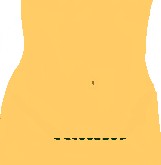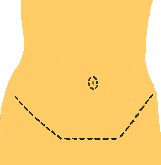Tummy Tucks
View Tummy Tuck Before and After Photos
What is a tummy tuck (abdominoplasty)?
What is the difference between a mini tummy tuck and a full tummy tuck?
What should you expect at your first abdominoplasty consultation with your plastic surgeon?
Will insurance cover any costs?
How much does a tummy tuck cost?
Who is a good candidate for a tummy tuck?
What will the recovery be like after a tummy tuck?
What is a tummy tuck (abdominoplasty)?
An abdominoplasty is a major surgical procedure that will remove excess skin and fat from the lower abdomen and tighten the abdominal muscles.
An incision is made across the lower abdomen from hipbone to hipbone. A second incision is made around the belly button. The skin and fat are separated from the abdominal wall. Excess skin and fat are then excised. The abdominal muscles are tightened by shortening them and suturing them together. A small incision creates a new opening for the belly button. It is brought out through the opening sutured to the new skin. Stretch marks and scars may be removed during surgery.
Drains may be placed in the skin and removed a few days later. The drains reduce swelling by collecting excess blood and fluid. All incisions are closed. The procedure is usually performed in a hospital or surgical center with an overnight stay.
What is the difference between a mini tummy tuck and a full tummy tuck?
A mini tummy tuck, or partial abdominoplasty, may be recommended for patients that are within 10% of their ideal body weight. This procedure is less invasive and can be done on an outpatient basis. While a full tummy tuck involves an incision around the navel and across the lower abdomen, a mini tummy tuck leaves the navel intact and requires a smaller incision. Liposuction is sometimes employed and the fat is removed from below the navel, tightening muscles from the navel to the pubis.
If your abdominal muscles require more extensive tightening and your body weight is more than 20% above your ideal weight, your plastic surgeon is more likely to recommend a full abdominoplasty. This frequently is performed with liposuction to obtain the best results.
The illustration on the left shows the incisions used for a partial abdominoplasty, or mini tummy tuck. The illustration on the right shows the incisions used for a full abdominoplasty, or full tummy tuck.
What should you expect at your first abdominoplasty consultation with your plastic surgeon?
At your initial consultation, your plastic surgeon will evaluate your health, determine the extent of fat deposits in your abdomen, and assess your skin tone. Be specific about what you would like done. If your plastic surgeon fully understands your expectations, he’ll be able to determine whether your goals are realistic.
If your fat deposits are limited to the area below the navel, you may require a less complex procedure called a partial abdominoplasty, also know as a mini-tummy tuck, which can often be performed on an outpatient basis. You may, on the other hand, benefit more from partial or complete abdominoplasty done in conjunction with liposuction to remove fat deposits from the hips, for a better body contour. Liposuction alone may also create the best result.
You are at increased risk for complications if you have diabetes, poor circulation, heart, lung or liver disease, smoke, have a family history of blood clots, take certain medications, etc. You’ll want to discuss your medical history thoroughly with your physician before you choose to undergo surgery.
Will my insurance cover a tummy tuck?
Insurance generally does not cover elective surgery. However, it may cover a portion of the abdominoplasty if there is excessive spreading of the anterior muscles or a hernia is present. Check with your insurance company, and be sure to obtain proper pre-authorization for your surgery.
How much does a tummy tuck cost?
Average Cost of Abdominoplasty Surgery*
Cost Range: $5,000-$9,000
Average Total Cost: $6,200
Surgeons fee: $5,000
Anesthesiologist: $500
Facility fee: $700
RELATED FEES**
Tummy tuck $5,232
Liposuction (suction-assisted) $2,697
Liposuction (ultrasound-assisted) $2,979
*Fees generally vary according to region of country and patient needs.
**These fees are averages only. Fees do not include anesthesia, operating room facilities, or other related expenses.
Who is a good candidate for a tummy tuck?
A good candidate for Abdominoplasty Surgery (Tummy Tucks):
- Is close to their ideal body weight (within 30%)
- Wants to remove specific areas of loose skin or fat that is diet- and exercise-resistant
- Weight has been stable for 6 months or more
- Has good skin tone and elasticity
- Has realistic expectations
- Is emotionally stable
- Understands the risks of surgery
If you do not meet all of these criteria, but meet some of them, you may still be a good candidate for a tummy tuck. The procedure is most suited to those who are close to their ideal body weight, but if you have a lot of fat in a isolated area, you may still be a good candidate.
If you intend to lose a lot of weight, wait until after your weight loss to schedule surgery. If you plan on future pregnancies, you should wait until you are done having children to have abdominoplasty surgery as pregnancy will stretch the abdomen again.
What will the recovery be like after a tummy tuck?
Pain Level: Moderate to severe discomfort. 1-2 weeks of pain medication
Swelling: 2-6 weeks
Numbness: 6 months or more
Bandages: Changed in 2-5 days (sutures removed first 7-10 days)
Work: Return to desk job after 1 week, other jobs 10-14 days
Exercise: Wait 4-8 weeks
Final result: After scars heal, approximately 6 months-1 year
For the first few days after surgery, the abdomen will probably be swollen and some pain and discomfort may occur which can be controlled by medication. Depending on the extent of the surgery, you may be released within a few hours or remain hospitalized for two to three days.
The incisions will be covered with surgical tape for two weeks to insure proper healing.
For faster recovery:
- Walk around every hour or so and flex your feet to prevent blood clots in the calf veins
- Keep your hips gently flexed for the first week to prevent tension on the sutures
- Do not shower until the drains have been removed (sponge baths until drains removed)
- Do not bathe for the first 2 weeks (showers permitted after drains removed)
- Be careful of surgical tape when showering
- Limit any activity that causes discomfort
For information on results and recovery, speak with your board certified plastic surgeon. Carefully follow your doctor’s advice to best assure proper healing and lasting results. These are general guidelines. Your surgeon knows your particular case best.
Related Links: Costs of Plastic Surgery | Tummy Tuck Before and After Galleries | Liposuction Before and After Galleries | Liposuction Information | Find a Plastic Surgeon | Plastic Surgery Guide



